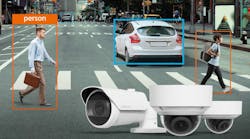At ISC West, I was privileged to moderate an educational session dealing with future trends in video. The panel, sponsored by Pivot3, included NVIDIA, which was a little puzzling to me at the time. If you are like me, your likely exposure to NVIDIA was when you bought your last PC and had the option to upgrade your graphics card to a more powerful option. If you did, it was to get better video rendering and response.
That capability is still a major part of NVIDIA’s repertoire, but I was curious why NVIDIA was presenting at or, for that matter, even attending ISC West. NVIDIA’s Adam Scraba and Saurabh Jain took the time to educate me about why they are excited about video surveillance. It is centered around the core of all of NVIDIA’s products — the Graphics Processing Unit (GPU) — which achieves extraordinary levels of processing power by using a large number of cores acting in parallel. This is in contrast to a standard CPU with a limited number of cores processing a task in sequential fashion.
The Power of GPUs
GPUs directly address the information and processing that can occur with image analysis at the pixel level. In the past, the field of computer vision used complex dedicated algorithms to analyze objects, but was limited by available processing power. The tasks lent themselves to massive parallel processing, but the cost to implement was prohibitive. A great example is facial recognition, where available processing power and cost limitations may lead to compromises — perhaps in resolution or in frame rate. GPUs change the game by packaging new levels of video/pixel processing performance affordably into widely available hardware.
The power of GPUs now enable real applications to use a form of artificial intelligence (AI) called “Deep Learning.” Rather than dedicated customized algorithms, the GPU is programmed to learn, like the neural network in a brain.
A June 2016 IEEE publication states: “Data lines possessed by each neuron of the network communicate with one another…The technique lets the network form neural relationships most relevant to each new situation.”
With exposure to lots of data of a specific type over time, the system gets smarter. Think of vehicle or license plate recognition, for example. A Honda CRV could be distinguished from an Acura RDX. State license plates could be recognized by portions of a design as well as the state name —just by showing the system a large sample of cars and license plates. Because the effort is in the learning, not the programming, accuracy goes up, scalability increases, and development costs tumble.
Impact on Video
Video analytics will become better and faster thanks to these GPUs. Analysis will be less constrained by pre-determined rules, making it easier to spot abnormalities. Video will become a relevant, valuable component in Big Data, because more useful metadata about the scene will be a part of the video file allowing search, sort, and aggregation after the fact.
Processing will enable video enhancement with far greater accuracy. It will assist decisions about whether to store or not store data, based on type of motion and scene characteristics. One industry projection estimates that by 2019, the world will be storing 2500 PB/day! IHS Technology forecasts 14.8% compound annual growth rate (CAGR) from 2014-2019. Thus, storing only what is needed will have enormous financial implications. And throughput is claimed to increase by a factor or 10 to 12 times.
Implementation of GPU technology may occur at several points, starting at the camera. The provisioned chips will replace current processors and contain CPU, GPU and all needed I/O. They will perform compression very efficiently as well as analytics. The projected cost differential to implement is in the $100-150 range.
NVIDIA projects gateways processing multiple video streams will be used in between the edge and the point of central processing, which may be in distributed storage devices or servers. These gateways, if needed, can decode and re-encode (transcode), in addition to performing image classification and enhancement.
Located centrally, very powerful servers may be configured using a GPU array. For example, Hikvision has presented a blade server product concept with 16 NVIDIA Tegra chips, citing a nice balance between computational power and decoding performance. The device exhibits 16 Tflops (16 trillion floating point operations per second) at a power consumption of 300 W, compared with a full rack of general purpose CPU servers of 14 Tflops @ 8 KW.
Early Adoption
Current GPU implementations in security are varied, covering such areas as anomaly detection, video analytic algorithms, traffic monitoring, facial recognition, visual search, video enhancement and analysis, VMS decoding, dewarping, and screen rendering, and virtual VMS.
“NVIDIA GPUs are critical to Pivot3’s Virtual Desktop Infrastructure (VDI) solutions, including the Virtual Security Server, which enables end users to access fully functional rich client desktop environments from any device in any location, without sacrificing functionality, bandwidth or data security,” explains Brandon Reich, Pivot3’s Senior Director of Surveillance Solutions. “This vastly improves response capabilities and situational awareness, enabling organizations to reduce overall security risk.”
While it is still early for deep learning in the industry, a number of security manufacturers are actively working with NVIDIA on building deep learning capabilities into new products. A notable example is Giant Gray (BRS Labs rebranded) — which for years has been developing non-rules based analytics, based on learning what is normal and flagging what is not.
Reich believes that by addressing the issues that have limited the adoption of video analytics- speed and accuracy, “the power and the promise of analytics will finally be unlocked.”
Adds NVIDIA’s Scraba: “We think this is going to be a new era in surveillance.”
Ray Coulombe is Founder and Managing Director of SecuritySpecifiers and RepsForSecurity.com. Reach him at [email protected], through LinkedIn at www.linkedin.com/in/raycoulombe or on Twitter, @RayCoulombe.




